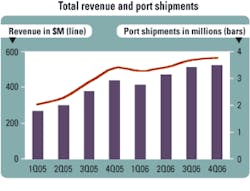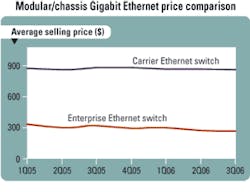by Seamus Crehan
Despite lofty industry expectations and a burgeoning Ethernet services market, Ethernet switches have experienced relatively limited deployment in carrier networks during the first half of this decade. To date, slightly more than 10% of total Ethernet switch revenues come from this source. However, the Carrier Ethernet switch market could well be undergoing a transition from limited deployments of inexpensive bandwidth to large-scale rollouts enabling carrier-grade services.
In the most recent quarter, Carrier Ethernet switch revenues traced a pattern similar to that of the prior quarter, with continued modest sequential growth and strong year-over-year growth. Quarterly revenues exceeded $550 million as port shipments approached 3.5 million (see Figure 1). These results put this market well on track to surpass $2 billion in 2006, a 33% annual increase over 2005.
Several factors are driving this strong market growth. First, because Ethernet is less expensive and more scalable than other technologies (specifically the incumbent ATM, Frame Relay, and SONET technologies), it has become the protocol of choice for carriers moving toward IP and packet-based networks. Therefore, service providers are increasingly deploying Ethernet switches in certain areas of the carrier network-most notably in the access and aggregation areas-so that they can offer high-bandwidth applications such as IPTV, storage backup, and videoconferencing more economically and effectively.
Second, more “carrier-class” Ethernet switches are available today. Vendors competing to capture the rising demand for Ethernet switches deployed in carrier networks are either adding carrier-grade features to existing product lines to make them more compatible with carrier network requirements, or building new product lines that target just this market. Multiprotocol label switching (MPLS) and Provider Backbone Transport (PBT) are examples of features that make Carrier Ethernet switches more scalable, reliable, manageable, and compatible with the existing carrier infrastructure (i.e., more “carrier class”). The Metro Ethernet Forum (MEF)-an organization consisting of carriers, system vendors, component vendors, and test vendors that works to accelerate the adoption of Ethernet networks and services in carrier networks-has developed certification procedures that help assure service providers that platforms meet certain “carrier class” criteria.Third, telecom service providers are aggressively pushing more services and content to the ever-growing number of broadband subscribers-246 million in 2006, up from 194 million in 2005-to compete with cable operators, who, by offering voice service through voice over IP, are invading telecom’s traditional markets. User adoption of these new telecom services will increase the average amount of per-subscriber bandwidth carriers must provide. In turn, the Ethernet switch is quickly becoming the platform of choice to transport this traffic to the core of the network.
The first wave of Ethernet switch deployments into carrier networks, often referred to as metro Ethernet, mainly targeted business applications. Those deployments replaced E1/T1 frame connections with Ethernet switches that delivered increased bandwidth to businesses at lower cost than the incumbent technologies.
Examples of some of these services include point-to-point connections between two sites, such as connecting a business to a service provider (a function similar to that provided by a SONET or TDM private line); connecting a business to the Internet or to a virtual private network (VPN); or enabling multipoint-to-multipoint virtual LAN (VLAN) connections. Although the number of business applications supported by Ethernet switches continues to expand, we estimate that these applications now drive a minority of total Carrier Ethernet switch revenues, as residential service revenues have now surpassed those of business.
The number of subscribers using broadband in their homes continues to increase. This growth, in conjunction with carriers aggressively marketing services (or service combinations) that require more bandwidth per subscriber, has resulted in a majority of Carrier Ethernet switches being deployed for residential applications. These higher-bandwidth services include IPTV and video-on-demand and are often offered in combination with other services, such as data and voice. User adoption of these combined applications is driving the need for increased network capacity to service the residential sector.
In addition to its use in business and residential applications, Carrier Ethernet equipment has recently seen opportunities in wireless cell-site backhaul applications. This segment currently composes only a small portion of the overall market today; however, we believe it could become a major driver of future Carrier Ethernet switch deployments. As mobile high-speed data, video, and multimedia services continue to expand, service providers will likely deploy Carrier Ethernet switches to aggregate this traffic.
Although the overall market average selling price declined 9% in the most recent quarter, Carrier Ethernet switch prices generally have held steady; for example, on a year-over-year basis, prices have fallen only 5%. Despite this decline, Carrier Ethernet switch prices remain significantly higher than those of enterprise Ethernet switches.
Figure 2 compares the average selling price of a modular or chassis Gigabit Ethernet port, which is the most important revenue segment for both Carrier Ethernet switches and enterprise Ethernet switches. Two main factors drive the Carrier Ethernet switch price premium. First, in contrast to enterprise switches, the majority of port shipments for Carrier Ethernet switches are fiber as opposed to copper, and fiber is much more expensive than copper. Second, Carrier Ethernet switches offer additional, sometimes proprietary, features intended to make these products more reliable, scalable, and manageable for carrier deployments.
A look at the vendor landscape shows Cisco holding the top position with slightly more than half of total market revenues. Over the past year or so, Cisco has aggressively introduced Carrier Ethernet switches and now has a broad portfolio of products for both the access and aggregation parts of the network. Cisco is positioning its carrier access switches as part of its Ethernet Fiber to the Home (E-FTTH) solution, which will compete with PON access technology.Alcatel, the second largest vendor in this market, derives the vast majority of its Carrier Ethernet switch revenue from the 7450 Ethernet Service Switch (ESS) product line developed by Timetra, a company that Alcatel acquired in 2003. Given Alcatel’s strong presence in DSL and the continued migration toward Ethernet uplinks on DSL access concentrators, the 7450 ESS-often deployed to aggregate these Ethernet uplinks-plays a key role in Alcatel’s strategy.
Another notable vendor in this space, Riverstone, was acquired by Lucent, which subsequently merged with Alcatel. It remains to be seen what will become of Riverstone’s Carrier Ethernet switch offerings given Alcatel’s strong presence in this space.
Nortel, which we believe derives most of its Carrier Ethernet switch sales from the EMEA region, has pioneered PBT. This technology enables deterministic paths or tunnels for the delivery of services across the network. In contrast to some other Carrier Ethernet technologies, PBT turns off some of the existing Ethernet functionality to enable new forwarding capabilities. Since PBT uses native Ethernet rather than an overlay network layer, it has the potential to be less expensive and less complex than other competing technologies, such as MPLS and VPLS.
Although Nortel recently announced that BT will be deploying its PBT solution as part of its 21CN business services rollout, it is too early to know the impact of PBT, especially because the standards completion for this technology is still a ways off. In addition to the Nortel equipment, BT will also deploy Siemens SURPASS hiD 6600 Carrier Ethernet switches with PBT as part of its 21CN rollout.
Extreme and Foundry Networks-which saw early success in this market centered around metro Ethernet (particularly in Japan)-have similar revenue shares. Extreme recently launched the BlackDiamond 12K, a platform that targets the Carrier Ethernet market. While Extreme and Foundry sell to both enterprises and carriers, many smaller vendors, including Atrica and World Wide Packets, focus solely on the carrier market. In contrast to North America, carriers are already replacing first-generation Ethernet switches in Asian countries such as Japan. This has helped local vendors such as Hitachi Cable. Huawei in China is another vendor that has seen good traction in its local market.
Clearly, the vendors that participate in the Carrier Ethernet switch market are a diverse group. While some leverage existing Ethernet switch offerings by evolving them for carriers’ needs, others focus exclusively on the carrier market. We anticipate that the number of Carrier Ethernet switch vendors will continue to increase as this class of product becomes more strategic in the carrier infrastructure.
Furthermore, we believe that this market is well positioned for growth, with more carrier acceptance of Ethernet switches and the ever-increasing bandwidth requirements for applications in business, residential, and wireless markets.Seamus Crehan is a senior director at Dell’Oro Group Inc. (www.delloro.com), where he covers the Carrier and enterprise Ethernet switch equipment markets.

